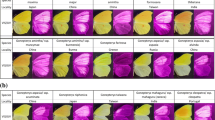Abstract
Common blue butterflies (Polyommatus icarus) sequester flavonoids from their larval host plants and allocate these UV-absorbing pigments to the wings. In field experiments using dummies constructed from female butterflies, mate-searching males inspected flavonoid-rich dummies more intensively than those with little or no flavonoids. Flavonoid content as signalled by UV-wing pattern may indicate ontogenetically determined female quality or enhance detectability to males.
Similar content being viewed by others
Author information
Authors and Affiliations
Additional information
Received: 21 March 2000 / Accepted in revised form: 17 May 2000
Rights and permissions
About this article
Cite this article
Burghardt, F., Knüttel, H., Becker, M. et al. Flavonoid wing pigments increase attractiveness of female common blue (Polyommatus icarus) butterflies to mate-searching males. Naturwissenschaften 87, 304–307 (2000). https://doi.org/10.1007/s001140050726
Issue Date:
DOI: https://doi.org/10.1007/s001140050726




